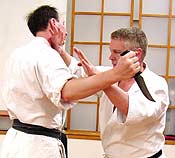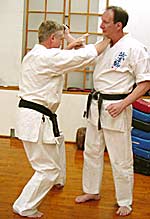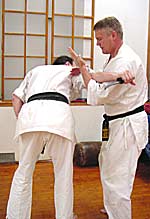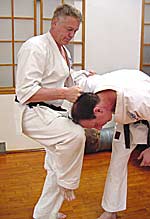Defeating A Downward Knife Stab:
An Introduction To Kata-Part 1
By Christopher Caile

Editor’s Note: Readers will note that this
article outlines another defense to this same attack discussed by other
authors. Yet, this defense is different too. It is one taken right out
of a well-known karate kata. Hopefully part 1 and 2 of this article will
help you appreciate the depth and sophistication of techniques that many
of you practice daily. Part 1 of this series is a quick overview of the
self-defense. Part 2 presents a detailed discussion.
If someone is aiming at your head with a bottle or club, an ineffective
defense might just get you knocked out. But if it’s a knife, your
life might be threatened.
Don’t say, “People don’t attack in this way.” I
have seen plenty of bar fights using the “hit them on the head
with a bottle” technique. I have also been attacked this way by
someone with a knife.
I was visiting a friend whose father had Alzheimer’s disease.
His father had lost a lot of his memory and didn’t remember me
although I had known him for years. He soon became agitated, and then
began to swear -- probably threatened by this stranger in his house,
someone who might be a danger to his son. I was told later that this
type of anger is symptomatic.
The next thing we knew he was in the kitchen, and we could hear him
fumbling in a drawer. My friend suggested we investigate and as I turned
into the kitchen, there he was on top of me thrusting downward with a
kitchen knife. My reaction was automatic -- a variation of the technique
I show below, except instead of hitting him (he was my friend’s
father after all, and we knew he was mentally incapacitated) I just blocked
and pushed his head back while controlling his arm.
The upshot was that I avoided real danger, and as a consequence of his
uncontrolled emotional reaction he was placed in an institution that
could better look after his needs.
While there are several defenses I might use against a downward knife,
bottle, club or baton attack (also a haymaker punch) depending on the
situation, this one is especially effective, particularly if you don’t
have much time to react, or have little room to move.
Take a close look at this defense. If you are a karate practitioner
you might have been practicing this for years. It’s right out of
the beginning of Pinan (Heian) four. Recognize all the moves? You might
not; many of them are disguised.
 |
|
 |
| Shift left to avoid the attack
while also blocking and striking up under the opponent’s
chin. | Grab the attacker’s arm while continuing to attack with
an elbow under the jaw. |
The right arm secures the attacker’s knife arm at the
shoulder while the left arm moves under it. |
| |
|
|
| |
Lock the knife in place while striking the attacker’s
neck. |
|
 |
|
 |
Grab the attacker’s hair and pull the head down to a knee
strike. |
(Seen from the other side) Force the opponent forward by leveraging
his knife arm upward while you also pull his hair. |
Take the opponent to the ground. Keep leverage on his arm while
bending it at the elbow and applying pressure to his wrist to release
the knife. |
Part 2 of this article amplifies the basics provided in this article.
It shows how each of the moves in this defense series relate to moves
in Pinan (Heian) four. There is also a technical discussion that illustrates
the genius of the kata itself -- its rich mix of strategy and technique
that make the Pinan kata, which looks so basic, so powerful.
About The Author:
Christopher Caile is the Founder and Editor-In-Chief of FightingArts.com.
He has been a student of the martial arts for over 43 years. He first
started in judo. Then he added karate as a student of Phil Koeppel in
1959. Caile introduced karate to Finland in 1960 and then hitch-hiked
eastward. In Japan (1961) he studied under Mas Oyama and later in the
US became a Kyokushinkai Branch Chief. In 1976 he followed Kaicho Tadashi
Nakamura when he formed Seido karate and is now a 6th degree black belt
in that organization's honbu dojo. Other experience includes judo, aikido,
diato-ryu, kenjutsu, kobudo, Shinto Muso-ryu jodo, boxing and several
Chinese fighting arts including Praying mantis, Pak Mei (White Eyebrow)
and shuai chiao. He is also a student of Zen. A long-term student of
one branch of Traditional Chinese Medicine, Qigong, he is a personal
disciple of the qi gong master and teacher of acupuncture Dr. Zaiwen
Shen (M.D., Ph.D.) and is Vice-President of the DS International Chi
Medicine Association. He holds an M.A. in International Relations from
American University in Washington D.C. and has traveled extensively through
South and Southeast Asia. He frequently returns to Japan and Okinawa
to continue his studies in the martial arts, their history and tradition.
In his professional life he has been a businessman, newspaper journalist,
inventor and entrepreneur.
|